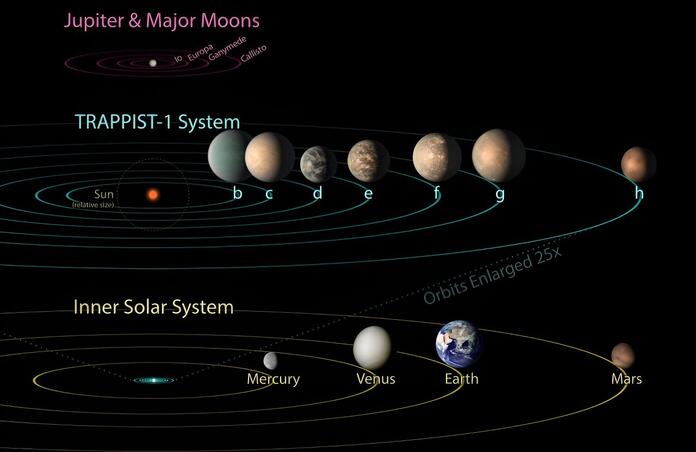Trappist-1 system found to have formed in two parts

Worlds outside of our solar system – or exoplanets – are challenging to directly to observe compared to stars and galaxies. As a result, almost all exoplanet discoveries have been due to photometric measurements of the stars which they orbit instead of the planets themselves. This is the transit method, where in cases when the planets orbit aligns with our line of sight will momentarily block light from the star when it passes in front.
The number of discovered exoplanets has grew tremendously in the past few decades, due to the help of many telescope missions. Over 5000 exoplanets have been confirmed, orbiting within thousands of systems.
When a star is born, a disk of gas and dust surrounds it, known as a protoplanetary disk. Majority of exoplanets form outside of this disk, and later migrate inwards towards the inner boundary. This gives rise to a planetary system which is much closer to the host star than our own solar system. If other factors are not considered, planets will undergo a standard migration process whereby the spacing between each planet is explained by their mass and gravitational forces between each other and the host star.
"The positions of the planets form resonances between their orbital periods. If you take the orbital period of one planet and then you divide it by the orbital period of its neighboring planet, you get a ratio of simple integers, such as 3:2." Explains Gabriele Pichierri, postdoctoral scholar research associate in planetary science at Caltech
An example is if an inner planet takes two days to orbit a star, the second planet will take 3 days to complete an orbit. if the second and third planet are also in a 3:2 resonance, the third planet will have a period of 4.5 days.
A particularly intriguing system which exhibits a multitude of resonance is trappist-1. This exoplanetary system hosts 7 planets and is located around 40 light years away. “The outer planets behave properly, so to speak, with the simpler expected resonances," Pichierri says. "But the inner ones have resonances that are a bit spicier.”
The tightly packed resonant configuration points towards disk-driven migration as the formation pathway of this system, however, the expected outcome would be first-order resonances. Instead, we observe high-order resonances in the innermost planets. For example, planet b and c are in 8:5 resonance, whereas c and d are in 5:3 resonance.
"This narrow discrepancy in the outcome of Trappist-1's assembly is puzzling and represents a wonderful opportunity to figure out in detail what other processes were at play in its assembly," he says. "In addition, most planetary systems are thought to have started in these resonant states but have encountered significant instabilities in their lifespan before we observe them today," Pichierri explains. "Most planets go unstable or collide with one another, and everything gets shuffled.
Even our own solar system was a victim of this instability. However, since the trappist-1 system remained stable, it provides a record of the dynamical history that scientists can study to understand the processes that occurred.
The main challenge for the team was constructing a model that could explain the orbits of the Trappist-1 system and how the current configuration was reached. The model developed suggests that the innermost 4 planets evolved alone initially in the expected 3:2 resonance chain. However, as the inner boundary of the disk expanded outwards, their orbits relaxed to the current observed configuration.
The fourth planet sat on the disks inner boundary when it formed, however, it moved further out with its expansion. It was then push back inwards when 3 additional outer planets joined the system, making up the current 7 planets.
"By looking at Trappist-1, we have been able to test exciting new hypotheses for the evolution of planetary systems," Pichierri says. "Trappist-1 is very interesting because it is so intricate; it's a long planetary chain. And it's a great exemplar for testing alternative theories about planetary system formation."
--
Cover image: NASA/JPL-Caltech/R. Hurt, T. Pyle (IPAC)
Journal source: Gabriele Pichierri et al, The formation of the TRAPPIST-1 system in two steps during the recession of the disk inner edge, Nature Astronomy (2024). DOI: 10.1038/s41550-024-02342-4. On arXiv DOI: 10.48550/arxiv.2406.08677
